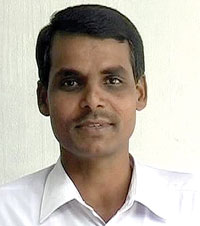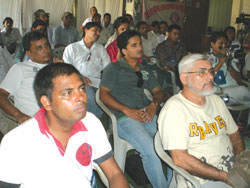|
|
| MEDIA IN CROSSHAIRS: Ram Sharaf of Terai TV and Jagadish Sharma of the newspaper, Prateek, share their concerns at a media meet in Birganj on Monday. Birendra Sah (below) who has been missing for a week after being abducted by suspected Maoists in Bara district. |
Birendra Sah had just started working for the new tv channel, Avenues. He also wrote for Dristi and Himal Khabarpatrika and reported for Nepal FM. He was riding out in his motorcycle to buy timber planks for his new house when he was abducted from the Pipara market near here on Saturday and hasn't been seen since.
A Federation of Nepalese Journalists (FNJ) mission on Monday found that Sah was taken away by local Maoists. Another reporter, Ram Dev Das, who was also abducted and later released after being beaten, confirmed the abductors were Maoists. The Maoist district in-charge has denied that his party was responsible, but Saturghan Nepal of FNJ Bara says eyewitness accounts left no doubt it was indeed the Maoists. The Bara kidnappings underline just how precarious the security situation has become in the tarai for journalists.
"Things were never this bad during the war, we could go anywhere," says Bharat Jarga Magar, who reports for Kantipur from Lahan, "these days you have to be careful about identifying yourself as a journalist."
 Across the tarai, reporters have themselves become internally displaced. Magar had to flee to Udaypur for safety after receiving death threats from activists not satisfied with the coverage of the January uprising in Lahan. Although he is back in Lahan, Magar's paper has appointed another reporter in Siraha to cover events south of the highway. Indeed, the East-West Highway has become the defacto frontier for many reporters of hill origin. Dilli Khatiwada used to be the Kantipur correspondent in Rajbiraj, he fled in February after getting threats and has now been transferred to Gaighat. When it became too dangerous in Inaruwa, Bed Raj Pokhrel had to relocate to Biratnagar.
Across the tarai, reporters have themselves become internally displaced. Magar had to flee to Udaypur for safety after receiving death threats from activists not satisfied with the coverage of the January uprising in Lahan. Although he is back in Lahan, Magar's paper has appointed another reporter in Siraha to cover events south of the highway. Indeed, the East-West Highway has become the defacto frontier for many reporters of hill origin. Dilli Khatiwada used to be the Kantipur correspondent in Rajbiraj, he fled in February after getting threats and has now been transferred to Gaighat. When it became too dangerous in Inaruwa, Bed Raj Pokhrel had to relocate to Biratnagar.
"As soon as we finish broadcasting our new bulletin, we start getting calls from people not satisfied with coverage," says Dipendra Chauhan of Radio Birganj, "there is a lot of intimidation and threats." Chauhan's station was vandalised by protestors in January who were angry that their agitation was not covered with prominence.
The polarisation in the tarai between communities got worse after January. At that time there were only two underground armed groups, there are now 22. Many are local warlords, criminal gangs and smugglers waving the madhes banner.
Reporters have received death threats for refusing to exaggerate the numbers attending rallies, or to file rumours of racially-motivated attacks, for not printing photographs. Reporting on smuggling, investigating timber poaching or the extortion racket along the border towns is so dangerous that few do it.
Many reporters in the tarai have stopped openly carrying note books or cameras, they don't display their IDs and keep a low profile. "It's now come to the point where I am targeted because of my complexion, slanted eyes, my name or my newspaper," said one tarai-based journalist who says he rarely ventures to the border towns these days.
Journalists have to do much more than just cover events, they are often called upon to mediate with militant groups to seek the release of abducted people or work to maintain communal harmony.
Rajesh Mishra, a journalist based in Malangwa in Siraha had to act quickly last month when rumours spread that local women visiting a shrine north of the highway for a festival had been raped. It wasn't true, and local militants had to be dissuaded from carrying out reprisal arson attacks in the town.
"After that incident, we set up a committee made up of media, civil society and the administration to prevent communal riots," says Mishra who is convinced race relations aren't irreversibly bad. It is probably because there are still journalists like Mishra, Magar and Chauhan that communal tensions in the tarai aren't worse than they are. There are numerous cases of radio stations that have refused to broadcast rumours and tried to keep things calm through mature reporting and public debate.
In Saptari, editors have decided not to print statements from any groups announcing bandas and protests, and all claims about protests are cross-checked.
Media got it wrong
The Kapilbastu riots last month showed how easily communal conflagration can take place if media gets things wrong, names the communities involved or sensationalises events.
It was after an FM station broadcast a live report about Moid Khan's supporters attacking hill villagers near Chandrauta last month that two mosques in the town were looted and vandalised. Before the police declared a curfew, two trucks and two motorcycles had already been set on fire and the mosques looted.
On 17 September Radio Nepal broadcast the news that five people were killed in a Maoist attack on prisoners at a police post in Jagdishpur. In fact, only two were killed and the prisoners named were still alive.
The total Kapilbastu death toll itself has had to be scaled back from 31 reported at the time to 15 with four still missing. Rather than being a spontaneous race riot, it now appears to have been a deliberate attempt to incite an ethnic pogrom. But most locals refused to be provoked and didn't retaliate.
Indian newspapers have also been responsible in spreading incendiary news items like this headline from Sahara: 'Maoists chasing out madhesis of Indian origin from Nepal'. The district administration has now banned Hindi papers.
JB Pun in Kapilbastu



